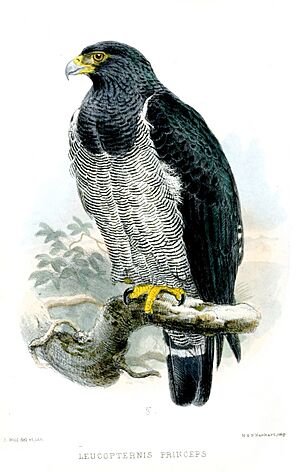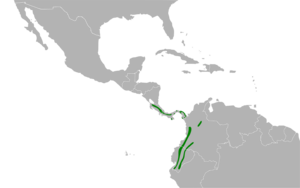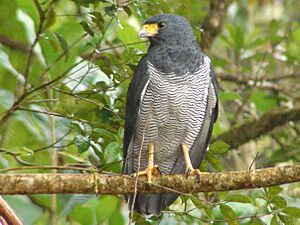Barred hawk facts for kids
Quick facts for kids Barred hawk |
|
|---|---|
 |
|
| Conservation status | |
| Scientific classification | |
| Genus: |
Morphnarchus
|
| Species: |
princeps
|
 |
|
| Synonyms | |
|
Leucopternis princeps |
|
The barred hawk (Morphnarchus princeps) is a type of bird of prey in the Accipitridae family. This family includes all hawks, eagles, and Old World vultures. Sometimes, it is also called the black-chested hawk.
You can find barred hawks in countries like Colombia, Costa Rica, Ecuador, Panama, and Peru. They mostly live in thick, moist forests, both in lowlands and on mountains. Scientists believe there are between 10,000 and 100,000 barred hawks living across Central and South America.
Contents
About the Barred Hawk
How Was the Barred Hawk Discovered?
The barred hawk was first officially described by a scientist named Philip Sclater in 1865. It belongs to the Accipitridae family, which is a large group of birds of prey.
What Does a Barred Hawk Look Like?
Barred hawks are mostly black from above, with a single white bar on their tail. Their belly and the underside of their wings are white with black bars. This creates a cool contrast with their black throat, chest, and wing feathers.
These hawks have a bill that looks a bit like a snout, making their head seem heavy. Even though they are quite large, their wings are not as wide as other big hawks. This helps them fly easily through dense forest trees.
A barred hawk is usually about 51 to 61 centimeters (20 to 24 inches) long. Its wings can spread from 112 to 124 centimeters (44 to 49 inches) wide. An adult barred hawk weighs about 1 kilogram (2.2 pounds). Female barred hawks are bigger than males. Their body is dark gray with a white chest. The black bars on their chest give them their name!
What Sounds Do Barred Hawks Make?
Barred hawks make different sounds, like high-pitched screams, whistles, or hoarse "whees." They also make "yips," "dits," and "weeps." When they are soaring high in the sky, they are usually quite noisy.
Where Barred Hawks Live
Barred Hawk Habitat and Location
Barred hawks live in a large area, covering about 350,000 square kilometers (135,000 square miles). They are mostly found in the middle parts of mountains in the Caribbean region. You can see them in Costa Rica, Peru, and Panama. They also live on both sides of the Andes mountains in northern Ecuador and western Colombia.
Their natural homes are moist forests, both in lowlands and on mountains. They prefer to live at elevations between 300 and 2,500 meters (980 and 8,200 feet) above sea level. They are most common between 900 and 1,600 meters (3,000 and 5,200 feet) high.
Barred Hawk Behavior
How Do Barred Hawks Hunt?
Barred hawks mostly hunt in the tops of trees, called the canopy, and along mountain forests. They use different hunting styles. Sometimes, they sit quietly on a branch, looking for prey. Other times, they soar noisily in the sky, often in groups of two or more.
These hawks rarely leave the forest to hunt, but they might hunt along the edges of the forest. When hunting inside the forest, they fly quickly and quietly from branch to branch. They usually perch at a medium or low height from the ground.
What Do Barred Hawks Eat?
Barred hawks hunt for slow-moving prey. Their diet includes frogs, snakes, small mammals, small birds, and large insects.
In one study in Ecuador, researchers looked at 104 food items brought to a barred hawk nest. Almost half (48%) of their prey were La Bonita caecilians. These are worm-like amphibians that live mostly underground. Another 35% of their diet was various snakes. Studies show that caecilians are a very important food source for barred hawks, especially after rain when these creatures come closer to the surface.



